Andreas Wenzel is not only an excellent jouster, he is also an excellent writer and has generously written several articles for The Jousting Life, both as himself and as the spokesman for Destrier.
He and his teammate Mark Caple recently won the Grand Tournament at Leeds Castle 2014 which took place in late August and was the last Destrier tournament this season.
The scores for the tournament(graciously provided by Emma Pearn) were as follows:
Leeds Castle Team(Mark Caple, Andreas Wenzel): 25 points
Royal Armouries Team(Jason Kingsley, Stacy van Dolah-Evans): 22 points
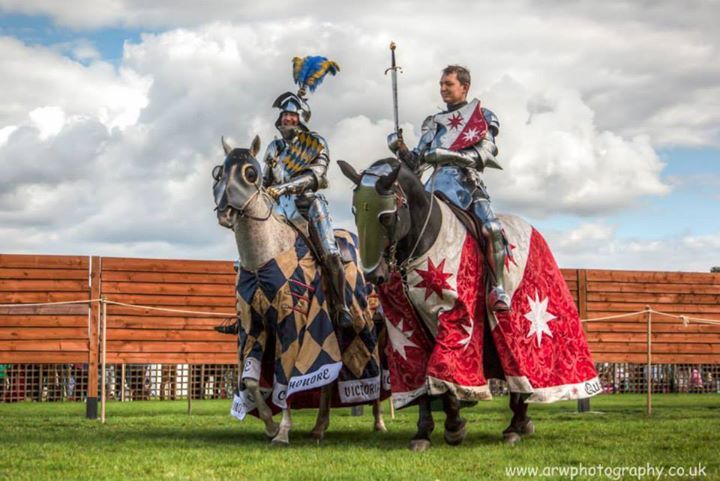
Mark Caple(left) and Andreas Wenzel(right), Team Champions of Leeds Castle Grand Tournament 2014(photo by ARW Photography)
Although there was no individual winner for this tournament, individual scores for the mounted skill at arms(MSA) competition and the jousting were given. The combined total is shown below. Note: although the mounted melee scores were an important part of this competition, no individual scores for mounted melee were given, only team scores. So the scores below do not accurately reflect how much each individual contributed to his team overall.
Andreas Wenzel: 20
Jason Kingsley: 17
Mark Caple: 13
Stacy van Dolah-Evans: 11
When asked to do an interview about winning the Leeds Castle Grand Tournament, Andreas preferred not to focus the interview on himself personally, but rather to focus it on Destrier as a whole.
This year's Leeds Castle Grand Tournament was a bit different from previous Destrier tournaments. Can you tell us about the format of the tournament at Leeds, and what made it different from other Destrier events?
Well, the first major difference was, of course, that the Leeds Castle tournament ran for five days – from Wednesday to Sunday. The second major difference was that this was not a competition between four individuals, but between two teams – one representing Leeds Castle (the host), the other representing the Royal Armouries (the guests).
Additionally we were asked by the client to differentiate the shows on the weekdays from the weekend. So we worked out a tournament schedule in which the two teams competed against each other in so-called “Combat Mounted Skill-at-Arms” [Combat MSA for short] shows during the weekdays, and then progressed to a grand melee and a grand joust on each weekend day.
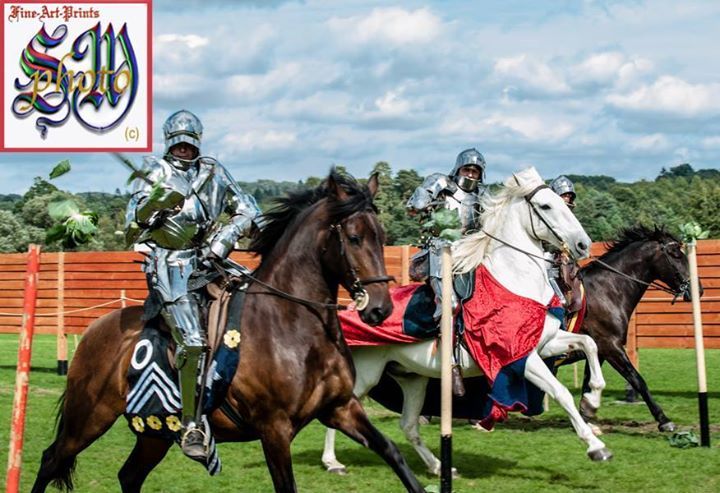
The Royal Armouries Team(Stacy van Dolah-Evans and Jason Kingsley, with Zac Evans as their third) in the Combat MSA competition during the Leeds Castle Grand Tournament 2014
(photo by Stephen Moss)
Combat Mounted Skill-at-Arms is a new display format we introduced last year, which is designed to test all the skills demanded of a mounted 15th century man-at-arms. Two teams comprised of three fully armed riders compete in three rounds. The first round tests ability and discipline during a cavalry charge. Each team runs with lances at rings while maintaining a line abreast. Once the ring targets have been passed, the riders discard their lances, draw side-arms, turn about, and run at the cabbages while still maintaining their line abreast. Points are awarded for the quality of the formation and number of targets taken. The second round tests martial horsemanship and close combat skills in a three-pass melee. In the third round, the skill with the lance is tried in a five-pass joust between an individual competitor from each team.
For the weekend, we switched gears to disciplines more representative of a medieval tournament, with a pretty grueling five-pass “grand” melee, and then the “grand joust” which pitched the jousters from each team against each other three times (six passes in total per competitor).
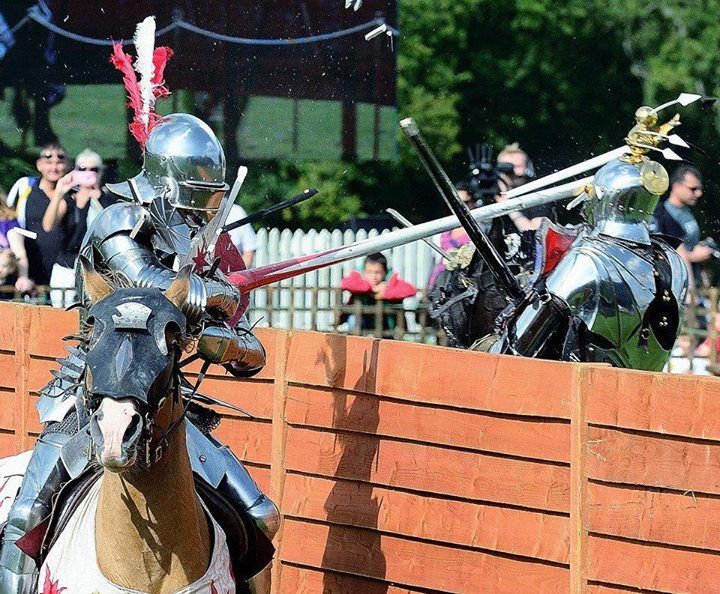
Andreas Wenzel and Stacy van Dolah-Evans both break their lances against one another during the Leeds Castle Grand Tournament 2014(photo by Richard Pearn)
The Leeds Castle Grand Tournament 2014 included one session that focused entirely on the mounted melee. Please, tell us about the differences between the mounted melee and the joust, and why the mounted melee is important.
I think most readers here will know that the joust is fairly simple as far as horsemanship goes. You canter your horse in a straight line, as close to the tilt rail as possible. Okay, you could debate nuances and get into whether left or right bend is better, and whether a Travere is preferable to a straight line, and whether and when you should accelerate before impact. Nevertheless, even at that level of refinement, I would maintain that the art and complexity of the joust lies predominantly in the handling of the lance – how and when do you couch, when do you lower your lance, how do you lower your lance, where do you then hit with how much accuracy and consistency, at which angle and therefore with how much force. In a good jouster all of this happens semi-automatically, drilled into muscle memory by years of training.
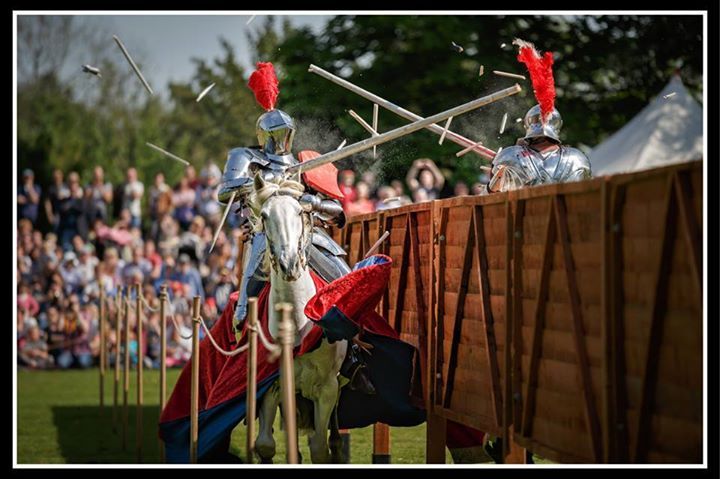
Jason Kingsley(left) and Andreas Wenzel(right) joust against one another at Hedingham Castle 2014(photo by NWY Photography)
As a discipline, the joust has its roots in testing the skills required during the initial charge in battle. The melee is important as it simulates what happens after that initial charge – when you’ve lost or broken your lance and are reduced to your side-arm. Then, suddenly, horsemanship prevails completely – your riding skills are as critical then as footwork is to the foot combatant, and no amount of fancy blade handling will save you if your horsemanship can’t get you out of the wrong position and into the right position.
The horses themselves will join the fight during a melee, keen to assert dominance over each other. I personally feel that there is a kind of dialogue between horse and rider, in which they agree who to attack or how to best get out of a tough spot. The best melee riders and their horses are perfectly harmonious teams, brothers in arms.
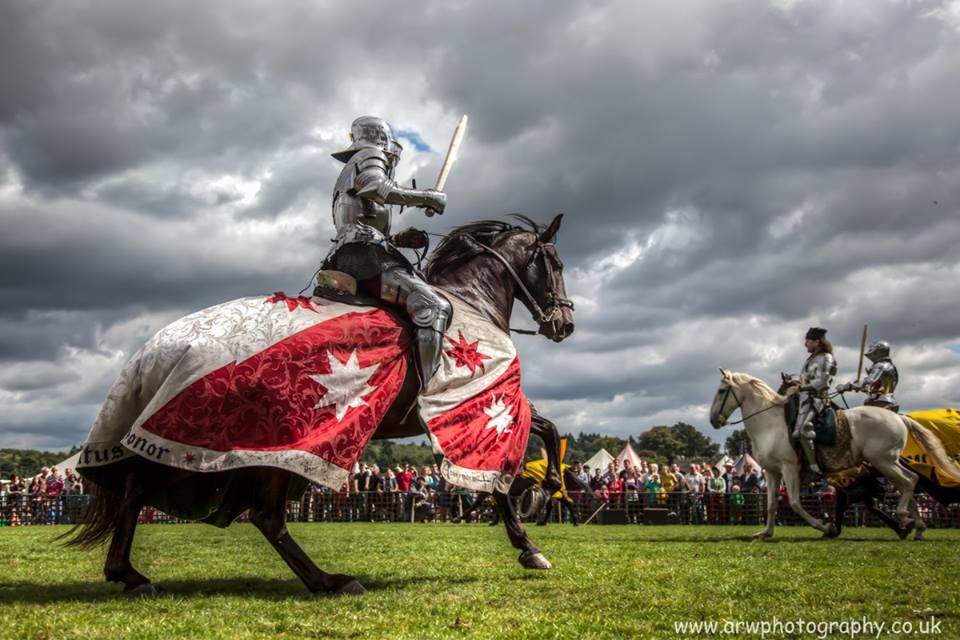
Andreas Wenzel and his mount Yeha look for opponents during the mounted melee at Leeds Castle Grand Tournament 2014(photo by ARW Photography)
That’s why the melee is so important in tournament, and why it was often regarded as superior to the joust – it relentlessly tests the skill of combatants and their horses, and makes immediately apparent if a competitor or his horse are either lacking in ability or not well aligned. As a discipline it is all about refined skill and complexity, as opposed to the joust’s brute force through automated motion.
So how did the session of mounted melee go?
A lot of melees you see around suffer from a general lack of impulsion, with the majority being fought at the trot, the walk or even the halt. This is not what would have happened – a rider in battle at the trot or the walk would have been dead almost straightaway. To keep alive, you would have had to maintain the canter at all times – this is the gait in which the horse is most maneuverable, quickest to accelerate, quickest to turn. Of course this considerably raises the bar in terms of the horses’ and the riders’ skill level. It also completely changes the dynamics of the melee – suddenly the riders move around the arena in what looks like a constant high-speed dance.
Just to explain the scoring properly: Each rider had a scorer watching him from the side lines. As soon as this scorer saw his rider getting hit twice, losing his weapon, getting unhorsed or dropping out of canter for longer than five seconds, he would shout and wave his hands to the Knight Marshal (the highly capable Dom Sewell). The Knight Marshal would then halt the melee, clarify the situation, and award a point to the opposing team. After this, all riders would return to their ends, and the next pass would begin.
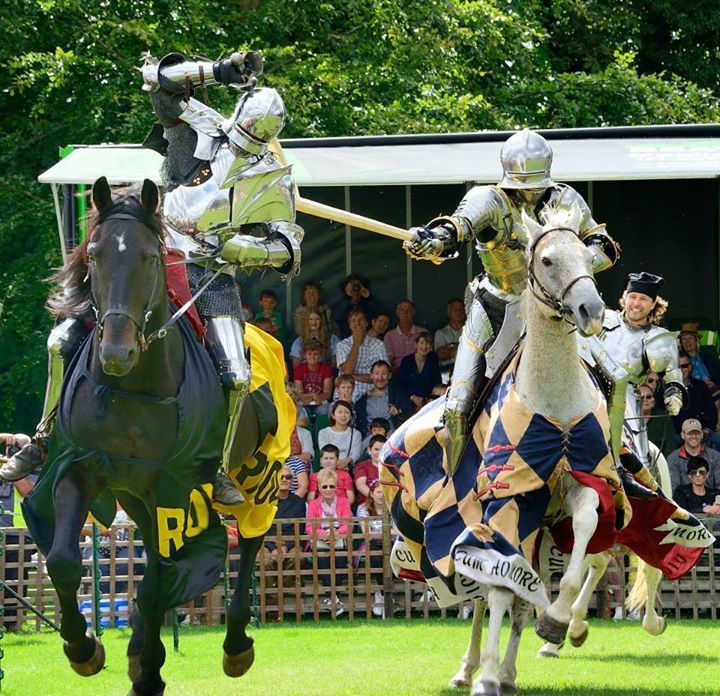
Mark Caple(right) strikes Stacy van Dolah-Evans(left) while Jason Kingsley watches from behind during Leeds Castle Grand Tournament 2014(photo by Richard Pearn)
Overall, and despite all the work we had done on this in training, the melees were really hard work. I felt that all riders were stretching their riding and physical abilities to their limits. I am delighted to say that we had some fantastic feedback from the public – the sheer sight of all this armour moving around a fairly restricted space at speed, throwing in flying changes and the occasional pirouette, ultimately leading to violent clashes when wooden clubs found their targets; the Knight-Marshal having to step in with raised voice to separate the furiously engaged combatants bout after bout – all this made for a fantastically dynamic and dramatic display, which was yet completely different from the joust and showed an aspect of 15th century mounted tournament the British public had not been treated to so far.
Just as in historical times, when different tournaments were run and scored differently depending on when, where and for whom they were held, modern jousting tournaments are run and scored differently depending on those involved in organizing them. Would you care to explain how Destrier tournaments are generally run and scored?
At most Destrier shows we don’t try and find an overall champion over several disciplines, so each event is scored on its own merits. During the mounted skill at arms(MSA) competitions, we usually give between one and three points for the cabbages, depending on how the cut was executed, between one and three points for the javelins, depending on where on the target they struck, and between one and three points for the rings depending on whether they were dislodged or taken, and how large the rings were. Quintains are usually scored with one point per revolution.
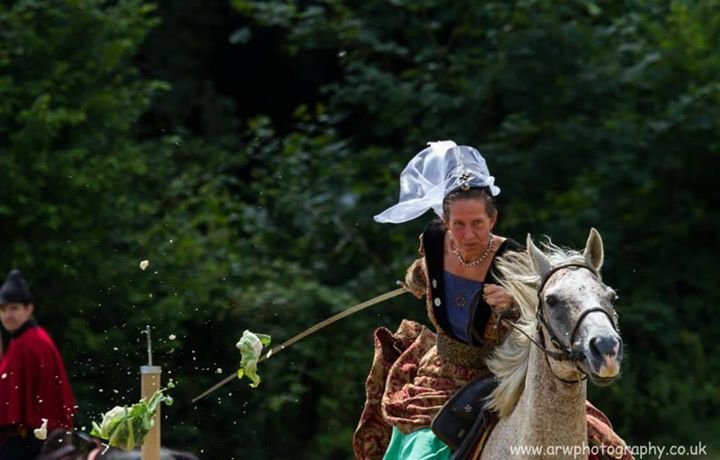
Tina Steiner, riding Argie, destroys a cabbage during a Hunting Games MSA competition
(photo by ARW Photography)
During the jousts, we typically give one point for a broken lance to the arm, two points for a broken lance to the breast plate, three points for a broken lance to the shield. Head strikes are subject to prior agreement between the jousters, and can either be considered illegal or awarded three to five points. We always award an extra point if the lance is broken particularly far down, to encourage hard hits. If a rider is unhorsed, he forfeits any points for that pass while his opponent receives the regular points for wherever he struck.
When we are aiming to award a championship across several events, we usually find that adding up the scores from each round is getting us to very high numbers. To enable the use of a scoring board, we therefore tend to use the concept of “victory points” on those occasions: the top scorer of an event will receive three victory points, the second-placed scorer two, the third-placed scorer one, and the last-placed scorer none. Where only two combatants are involved (for example when scoring for two teams, or in a two-man joust) the winner receives three points, the loser none.
Does each Destrier rider have a specific horse or horses that he/she usually rides? Please tell us about your horses.
No, generally not – the majority of our riders do not own their own horses, or if they do, they don’t use them for Destrier events. The only real exceptions to this rule are Jason Kingsley who usually rides his PRE gelding Warlord, and Tina Steiner who prefers to work with her PRE mare Zahara.
Destrier usually rents specially trained stunt and re-enactment horses from professional horse suppliers. In 2014 we worked with Nicky Willis/Tournament Stud and Dom Sewell/Historic Equitation. Next year we will work again with Nicky Willis and hopefully Dom’s Historic Equitation, but also with Mark Atkinson’s Atkinson Action Horses. Between them, these suppliers provide horses in a wide variety of breed and skill levels – the breeds we use include cobs and polo ponies just as much as Spanish, draft and sport breeds. Every Destrier rider is expected to work with a wide variety of mounts, and a large part of our training aims at broadening each rider’s available horse base.
However, I guess all of us have our favourites. If you take me personally for example, I spent most of my events this year with Nicky Willis’s Yeha (PRE) and Dom Sewell’s Marduc (Belgian Warmblood), but also rode Tournament Stud’s Argie (Polo Pony) and Coal (a Hungarian breed, possibly a Nonius), Nicky Willis’s Burt (Dutch Warmblood), Donk (a Polish breed, possibly a Polish draft cross), Tikka (Polo Pony) and Dom Sewell’s Hawthorne (Friesian x Cob). I also had the exquisite pleasure of spending a whole week with Ben Atkinson’s PRE stallion Sonyador – although that was at Arundel Castle, not during a Destrier event.
Riding many different horses is a core part of our culture at Destrier. If you were to sit by the Destrier camp fire during one of our events, you’d most likely hear members discussing the merits of different horses, exchanging tips about how best to ride each of them, or reminiscing about a horse which in the past had touched their heart.
Besides the Grand Tournament at Leeds Castle, what were some of the other tournaments that Destrier staged during 2014?
This year our event calendar included a small St. George’s Display with some skill-at-arms at Dover Castle, as well as full Destrier events (i.e. jousts with either Hunting Games MSA or Combat MSA competitions) at Hedingham Castle, Bodiam Castle, the Chalke Valley History Festival, and Herstmonceux Castle.
A very important event for us each year is the re-enactment of the Battle of Bosworth, where we perform our usual Hunting Games and Jousting competitions, and also provide cavalry for the battle, performing Richard III’s famous charge.
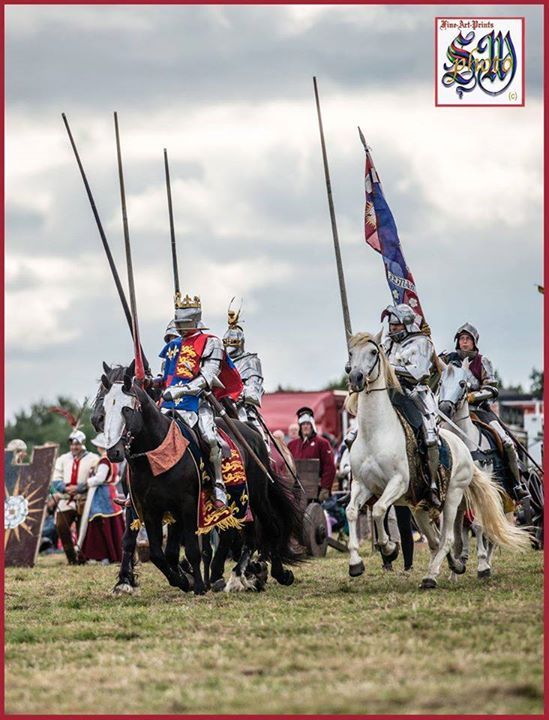
Members of Destrier re-enact the charge of Richard III during the Battle of Bosworth 2014
(photo by Stephen Moss)
In addition we have developed a habit of challenging all re-enactors present to combat on foot in form of a Pas d’Armes, which is brilliant fun and provides opportunity for a bit of friendly ... ahm ... rivalry.
I feel we are truly privileged to perform at all these beautiful venues – there’s nothing quite like riding through an original castle gate in full armour together with your brothers and sisters in arms. Next year we hope to change events around a bit, adding a few new venues to the diary.
You mentioned Arundel Castle earlier. The Arundel International Tournament is often affiliated with Destrier in the press, but I notice you did not mention it in the previous question. Is Arundel a Destrier event, or not?
The Arundel International Tournament is not a Destrier event. The reason that it is often linked to Destrier is because of its history, and because so many Destrier members are involved with it. The initial jousting events at Arundel, prior to about 2006 I think, were staged by the Royal Armouries Display Team. In about 2006 this changed and went over to Destrier, who then performed there until 2009, first as Destrier and then as Destrier Pro. The principal format of today’s tournament was more or less defined during that period.
As part of a reshuffle within Destrier, the Arundel tournament was then turned over to Stacy van Dolah-Evans who since then has run the event as a production separate from Destrier, and has grown the tournament to the leading position it has today. Nevertheless, many key figures of the tournament remain Destrier members, as for example Stacy himself, his wife Kyle (the Lady of Honour at the tournament), the commentator Kate Vigurs, and many of the ground and support crew. Stacy is a close friend, and I myself have been riding at the tournament for years and have also helped out a bit with the organization – I am proudly responsible for the insane and utterly unintelligible scoring system of the competition!
Many of Destrier’s jousters also compete in international tournaments and and are quite successful. Destrier’s Sean George won two Team Championships this year, one at Gniew Castle in Poland and another at Bicolline in Canada. Mark Caple has also been very successful, winning this year’s Queen’s Jubilee Horn Trophy and last year’s Team Championship at Arundel International Tournament with Stacy van Dolah-Evans. Stacy is another Destrier rider who has won Royal Armouries tournaments twice and a Team Championship at Lachute in Canada. And then there are your own successes, including, amongst others, two championships on the WorldJoust circuit, two championships at Arundel Castle, and of course the Squire’s Championship at Sankt Wendel. What is the secret to Destrier’s competitive success?
To be perfectly honest, I don’t believe that these successes are owed primarily to a membership in Destrier, but much more to the fact that all those riders are living (or have been living) in the UK. England just offers a huge wealth of jousting opportunity to riders capable of seizing it. Destrier alone has staged 22 jousting displays across seven events this year, and that does not include the numerous jousting events held by English Heritage, the Royal Armouries, or other historical jousting teams. British jousters just have a lot more opportunity to practice their sport than many other competitors in the world.
That said, we do of course pride ourselves on our training, and I feel that the capability to ride a variety of horses, as mentioned earlier, is probably making it easier for Destrier riders to succeed internationally. We all try to help each other get better, and equally try to learn from each other. At training and during events, all of us watch each other, and everybody chips in with tips and hints to improve. A major part of being successful is, for example, how well your armour works. This is something everybody is interested in at Destrier – when somebody turns up with a new piece of armour, half the society is involved in marveling, testing, fitting and debating.
I personally really enjoy it when one of our guys comes back from an international event and we share our experiences with each other by the camp fire or during training. Equally, I love those moments when we exchange views and analyze passes after a joust.
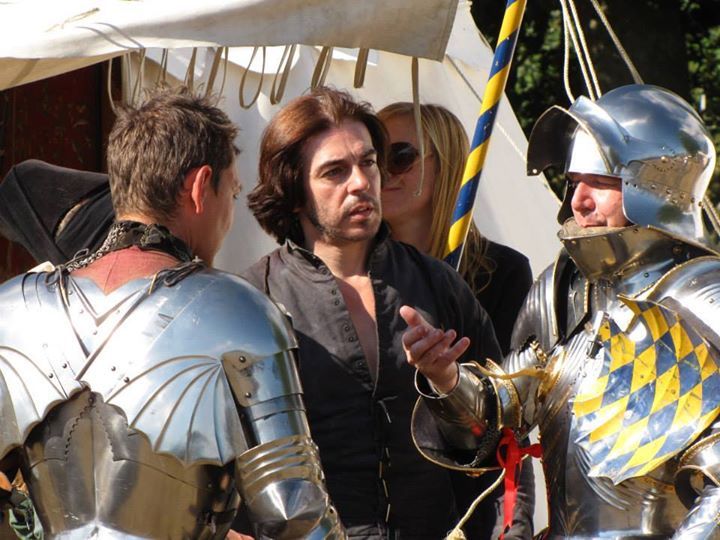
Andreas Wenzel, Sean George and Mark Caple discuss a jousting pass at Bodiam Castle 2013(photo from Bodiam Castle/Mr E. Sampson)
I like to think of Destrier as a family – not everybody always gets along, and there may have been a few black sheep over the years, but ultimately we all know that we belong together. When in battle or in tournament, I know of no man or woman I’d rather have by my side than a fellow Destrier rider.
From all this, it seems apparent that Destrier is a jousting team. Yet on Destrier’s website you characterize yourselves as a cavalry display team, using the phrase “15th century mounted soldiery”. How is this reflected in the society’s activities?
You need to know that Destrier was born as a 15th century cavalry unit back in 1996 and mostly focused on providing mounted units for battle re-enactments until its’ riders started experimenting with jousting in 2000. So the traditional focus of the group has always been in mounted battle re-enactment rather than tournament. However, it is a fact of life that horses are expensive and no event organizer is willing to spend a lot of money just to add some horsemen to a battle display. As a result, the society has developed a considerable focus on tournament, and pretty much all our events are now headlined by a jousting display.
That said, the cavalry element has always been maintained. Our training includes considerable elements focusing on cavalry skills like formation riding and melee combat, and all our jousters maintain armour for battle. Sadly, opportunity to provide cavalry is pretty limited, mostly to Bosworth and the occasional display at English Heritage’s History Live! event.
However, when the opportunity presents itself, we will certainly seize it. One such occasion arose last year, at Bexbach 1474 - Call to Arms in Germany. Several hundred 15th century reenactors came together for three days in the western countryside of Germany, exactly where the historic border between the Duchy of Burgundy and the Holy Roman Empire was located. They found themselves a LARPing area of several hectars. In that, they put the Burgundian camp at one end onto a hill, and then the Imperial camp into a valley about a mile away. Then they said “You are now free to fight each other until 12.00 noon the day after tomorrow.”… Wow, what an event.
The guys from Stichting HEI had been at the event the year before, with three horses, and what they said about it just sounded fantastic. So last year Destrier decided to bring five horses over, and so did Stichting HEI. What an experience. My memories feel like looking back into the mists of time, seeing myself figuring out enemy troop movements in the far distance, noticing tack and armour glinting in the forest to our flank, ordering a charge while moving around thickets… amazing.
You mention Stichting HEI, who refer to Destrier as their sister group in their report on the Bexbach event. Would you mind telling us a little bit about the relationship between the two societies?
Stichting HEI and Destrier share the same origins, and the same objectives. When Destrier began jousting for English Heritage in 2002, the society’s core team (in those days Rob Martin, Dom Sewell and Stacy van Dolah-Evans) was re-enforced by Joram van Essen, and later Arne Koets. Both of them were members of Destrier in those days, but they were also key figures around the foundation of Stichting HEI (they can probably tell you more about the exact circumstances of Stichting HEI’s birth).
The two societies maintained quite close relations early on, with many shared stories and adventures – in fact I recall attending a HEI event in the Netherlands as a squire just after I joined Destrier in 2003. Relations quietened somewhat later on, as both societies went through their own challenges and changes. I personally was really excited when HEI and Destrier joined forces at Bexbach after all those years – the two groups just somehow slotted together, as if we had trained with each other for ages. It was a bit like meeting a sibling after a long time.
It's a little hard for outsiders to keep track of the members of Destrier. Who is now actually a member of Destrier? And how many members are there?
This is probably because of Destrier’s long history. Many well-known jousters have at one point been members of Destrier, and are still associated with the society. Also, members have to renew their membership with the society every year, and we have quite a bit of fluctuation from one year to the next.
At the AGM[annual general meeting] in October 2014, Destrier had a total of 36 members, which included ten jousters, 14 non-jousting riders and twelve non-riding ground crew. You will understand that I can’t name all of them, but Destrier’s committee members as elected at our recent AGM are myself as Chairman, Mark Caple as Vice-Chairman, Ben Green as Secretary, Sue Alderman as Treasurer, and Tina Steiner as supporting committee member.
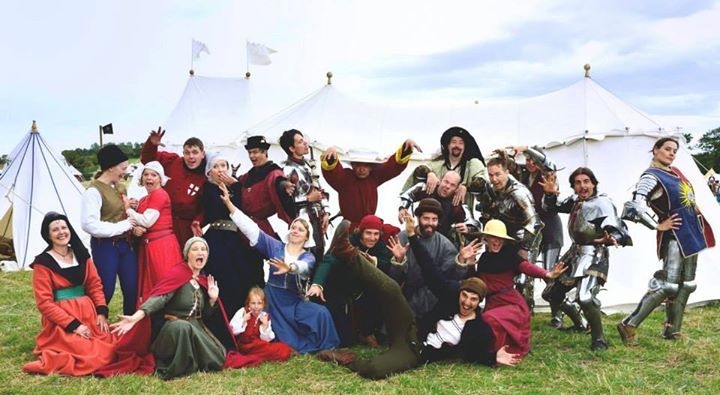
Many, but not all, of the Destrier team members at the Battle of Bosworth 2014
(photo by Christine Pearn)
Destrier is known for the high quality of the armour worn by its members. Can you tell us a little bit about Destrier’s approach to armour and equipment?
Well, I think I have mentioned before that many of Destrier’s members have a keen interest in 15th century armour. We love discussing it, and comparing it, and competing for the best and shiniest harness – it’s part of what makes us Destrier. There’s little more exciting for me than one of our members turning up with a new piece of armour.
Almost all of Destrier’s harnesses are based on original sources, and were then realized by a skilled armourer with specific experience of building armour for riders. Most of the Destrier armours are made by Will West of Englyshe Plate Armourie, who is also a long-standing Destrier member and retired jouster. Many other pieces in the group have been made by Dave Hewitt of White Rose Armoury, Matt Bailey of Matt Black Armour, and others. Some of our harnesses are based on extant pieces (like Mark Caple’s A62 replica), some on effigies (like Graham Turner’s Fitzherbert harness, and Ben Green’s Beauchamp interpretation), some on paintings (like Zac Evans’ and my own Pacher harnesses).
A lot of research went into each of our armours. Let’s take mine as an example: My harness is a South-German/Tyrolean design of around 1465. It’s been an aspiration of mine to build a German harness from the 1460’s, which was not at all straightforward as references for this period are pretty hard to find. Most depictions of German harnesses and almost all extant pieces you see around are from the 1470’s and later. After going through all the usual sources and coming up empty, I ended up finding a modern drawing in a German book by Ulrich Lehnart showing a very distinct design for 1460’s Germany.
I contacted the author, who very kindly revealed his source material for the drawing as paintings by various Tyrolean artists including Michael Pacher and the Master of Uttenheim. He pointed me to an old exhibition catalogue featuring those paintings, which however has been out of print for some time. When I finally found a copy of that catalogue in a bookshop in Augsburg I was very happy and excited. (Nowadays I know that the original paintings are on display in the Austrian Gallery in Vienna.)
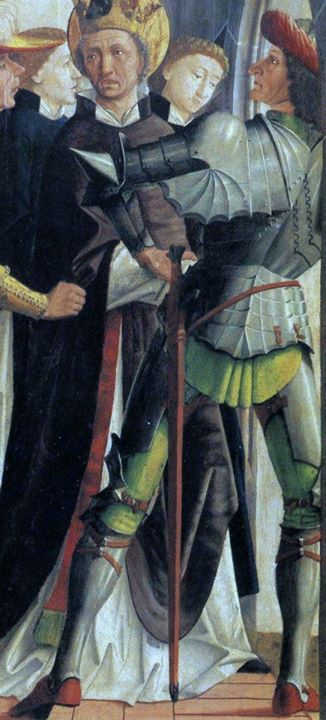
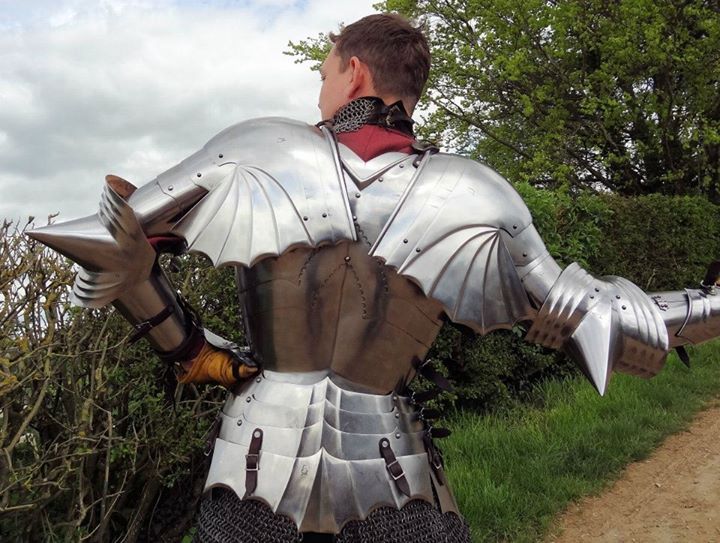
A detail of the altar painting, c1465, by Michael Pacher at the parish church of St Lawrence, originally in Southern Tyrol, now in the Austrian Gallery in Vienna and a photo of the back of Andreas Wenzel's armour(photo from Destrier)
What are Destrier's plans for the future?
In my view, the society’s current focus is very clearly on the recruitment and training of a new generation of Destrier jousters, and on maintaining a solid and varied event base at attractive locations that allow those jousters to develop their skills. It usually takes a member about three years from joining the group to breaking his first lance, so this is a pretty long-term project.
At the same time we are working to bring historical (“real steel”) jousting to venues all over Britain, so more and more people can get an impression what the real thing looks like, as opposed to theatrical jousting.
Our big challenge right now is to bridge the contradiction of lifting the game with our experienced jousters to the next level, while at the same time keeping standards accessible so new members can come into the group and develop. I am quite happy with how we managed in 2013 and 2014, and I feel we’ve really pushed our game at Bexbach and Leeds Castle amongst other events. On this we have to build – I like to think there is a hunger in the Destrier society to push the boundaries again, to try new things.
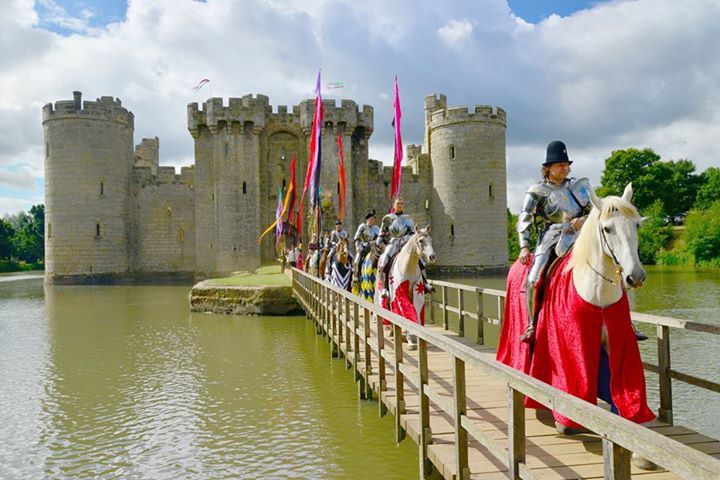
Destrier jouster Jason Kingsley leads other members of Destrier across the bridge at Bodiam Castle(photo by Richard Pearn)
Once we have accomplished our objective of further broadening the jouster base, I think some of us might be tempted to revisit Destrier’s foray into shaped solid lances back in 2008/2009, and build on the pioneering work of Arne Koets and Stichting HEI. And another Bexbach-type event would be brilliant.
One last question for you personally: If you could produce your ideal tournament, what would it be like? (If money, etc... were not a consideration.)
To be very honest, I feel the tournaments available today are not leaving a lot to be desired. The shaped solid lance events like Nyborg or Schaffhausen are achieving an incredible level of accuracy where further improvement is bound to be mostly academic. On the other hand the leading balsa tipped lance tournaments like Arundel, the big Lysts on the Lake event in 2012, and the WorldJoust events are starting to properly achieve the competitive element and are really transporting the concept of jousting as a sport to the public.
Something I would find very exciting would be the recreation of a trial by combat along the lines for example of the famous confrontation between Jaques le Gris and Jean de Carrouges, although of course interpreted “a plaisance”. Imagine two combatants with a range of weapons in a closed arena. Both would enter mounted with solid lances and confront each other openly (without a tilt). Once lances are broken, they would proceed to mounted melee with weapons of their choice. Leading on from that they may dismount to engage on foot with axes or hammers… that would be a truly awesome project. There’s not many people in the world who would qualify as a combatant though…
On the competitive side, I would love to see a proper world championship being staged with balsa tipped lances which actually brings together all the sport’s centre stage individuals from around the world – which has often been attempted and even claimed, but in my opinion was never truly achieved. I am talking about European historic jousters getting together not only with their equivalents from Northern America, Australia and New Zealand, but also with the top riders from the global IJA/IJL community, and the US heavy jousters – wouldn’t that be a spectacle?
I like to think it’s possible, but you’d have to specifically approach certain leading competitors from each grouping and convince them to join in. Then of course you’d somehow have to figure out an equipment standard, a venue suitable to all, funding to enable financial support, and a sufficient supply of trained hire horses… Going forward you’d have to define a set of representative qualifier tournaments in each major jousting region in the world… and I imagine you’d have to hire NASA to wrangle all the planet-sized egos.
Thank you so much, Andreas, for doing this interview, and best of luck in all your future endeavors!

Andreas Wenzel, after winning the Individual Championship at the Arundel International Tournament 2013(photo from Arundel Castle)
Related articles:
There are quite a few articles featuring members of Destrier
Training for the Joust with Destrier
Destrier at Hedingham Castle
An Interview with Jouster Mark Caple, Champion of the "Queen's Jubilee Horn Tournament 2014"
Interview with Sean George, Half of the Winning Team England at the Tournament of King Jan III at Gniew Castle 2014
He and his teammate Mark Caple recently won the Grand Tournament at Leeds Castle 2014 which took place in late August and was the last Destrier tournament this season.
The scores for the tournament(graciously provided by Emma Pearn) were as follows:
Leeds Castle Team(Mark Caple, Andreas Wenzel): 25 points
Royal Armouries Team(Jason Kingsley, Stacy van Dolah-Evans): 22 points

Mark Caple(left) and Andreas Wenzel(right), Team Champions of Leeds Castle Grand Tournament 2014(photo by ARW Photography)
Although there was no individual winner for this tournament, individual scores for the mounted skill at arms(MSA) competition and the jousting were given. The combined total is shown below. Note: although the mounted melee scores were an important part of this competition, no individual scores for mounted melee were given, only team scores. So the scores below do not accurately reflect how much each individual contributed to his team overall.
Andreas Wenzel: 20
Jason Kingsley: 17
Mark Caple: 13
Stacy van Dolah-Evans: 11
When asked to do an interview about winning the Leeds Castle Grand Tournament, Andreas preferred not to focus the interview on himself personally, but rather to focus it on Destrier as a whole.
This year's Leeds Castle Grand Tournament was a bit different from previous Destrier tournaments. Can you tell us about the format of the tournament at Leeds, and what made it different from other Destrier events?
Well, the first major difference was, of course, that the Leeds Castle tournament ran for five days – from Wednesday to Sunday. The second major difference was that this was not a competition between four individuals, but between two teams – one representing Leeds Castle (the host), the other representing the Royal Armouries (the guests).
Additionally we were asked by the client to differentiate the shows on the weekdays from the weekend. So we worked out a tournament schedule in which the two teams competed against each other in so-called “Combat Mounted Skill-at-Arms” [Combat MSA for short] shows during the weekdays, and then progressed to a grand melee and a grand joust on each weekend day.

The Royal Armouries Team(Stacy van Dolah-Evans and Jason Kingsley, with Zac Evans as their third) in the Combat MSA competition during the Leeds Castle Grand Tournament 2014
(photo by Stephen Moss)
Combat Mounted Skill-at-Arms is a new display format we introduced last year, which is designed to test all the skills demanded of a mounted 15th century man-at-arms. Two teams comprised of three fully armed riders compete in three rounds. The first round tests ability and discipline during a cavalry charge. Each team runs with lances at rings while maintaining a line abreast. Once the ring targets have been passed, the riders discard their lances, draw side-arms, turn about, and run at the cabbages while still maintaining their line abreast. Points are awarded for the quality of the formation and number of targets taken. The second round tests martial horsemanship and close combat skills in a three-pass melee. In the third round, the skill with the lance is tried in a five-pass joust between an individual competitor from each team.
For the weekend, we switched gears to disciplines more representative of a medieval tournament, with a pretty grueling five-pass “grand” melee, and then the “grand joust” which pitched the jousters from each team against each other three times (six passes in total per competitor).

Andreas Wenzel and Stacy van Dolah-Evans both break their lances against one another during the Leeds Castle Grand Tournament 2014(photo by Richard Pearn)
The Leeds Castle Grand Tournament 2014 included one session that focused entirely on the mounted melee. Please, tell us about the differences between the mounted melee and the joust, and why the mounted melee is important.
I think most readers here will know that the joust is fairly simple as far as horsemanship goes. You canter your horse in a straight line, as close to the tilt rail as possible. Okay, you could debate nuances and get into whether left or right bend is better, and whether a Travere is preferable to a straight line, and whether and when you should accelerate before impact. Nevertheless, even at that level of refinement, I would maintain that the art and complexity of the joust lies predominantly in the handling of the lance – how and when do you couch, when do you lower your lance, how do you lower your lance, where do you then hit with how much accuracy and consistency, at which angle and therefore with how much force. In a good jouster all of this happens semi-automatically, drilled into muscle memory by years of training.

Jason Kingsley(left) and Andreas Wenzel(right) joust against one another at Hedingham Castle 2014(photo by NWY Photography)
As a discipline, the joust has its roots in testing the skills required during the initial charge in battle. The melee is important as it simulates what happens after that initial charge – when you’ve lost or broken your lance and are reduced to your side-arm. Then, suddenly, horsemanship prevails completely – your riding skills are as critical then as footwork is to the foot combatant, and no amount of fancy blade handling will save you if your horsemanship can’t get you out of the wrong position and into the right position.
The horses themselves will join the fight during a melee, keen to assert dominance over each other. I personally feel that there is a kind of dialogue between horse and rider, in which they agree who to attack or how to best get out of a tough spot. The best melee riders and their horses are perfectly harmonious teams, brothers in arms.

Andreas Wenzel and his mount Yeha look for opponents during the mounted melee at Leeds Castle Grand Tournament 2014(photo by ARW Photography)
That’s why the melee is so important in tournament, and why it was often regarded as superior to the joust – it relentlessly tests the skill of combatants and their horses, and makes immediately apparent if a competitor or his horse are either lacking in ability or not well aligned. As a discipline it is all about refined skill and complexity, as opposed to the joust’s brute force through automated motion.
So how did the session of mounted melee go?
A lot of melees you see around suffer from a general lack of impulsion, with the majority being fought at the trot, the walk or even the halt. This is not what would have happened – a rider in battle at the trot or the walk would have been dead almost straightaway. To keep alive, you would have had to maintain the canter at all times – this is the gait in which the horse is most maneuverable, quickest to accelerate, quickest to turn. Of course this considerably raises the bar in terms of the horses’ and the riders’ skill level. It also completely changes the dynamics of the melee – suddenly the riders move around the arena in what looks like a constant high-speed dance.
It also completely changes the dynamics of the melee – suddenly the riders move around the arena in what looks like a constant high-speed dance.So the primary challenge of putting on a well-run melee is to keep all riders in the canter at all times. To ensure this at Leeds Castle, we introduced the Sankt Wendel “canter rule” – if any rider dropped out of canter for longer than five seconds, he would be counted out, the melee would be stopped and his team would lose a point.
Just to explain the scoring properly: Each rider had a scorer watching him from the side lines. As soon as this scorer saw his rider getting hit twice, losing his weapon, getting unhorsed or dropping out of canter for longer than five seconds, he would shout and wave his hands to the Knight Marshal (the highly capable Dom Sewell). The Knight Marshal would then halt the melee, clarify the situation, and award a point to the opposing team. After this, all riders would return to their ends, and the next pass would begin.

Mark Caple(right) strikes Stacy van Dolah-Evans(left) while Jason Kingsley watches from behind during Leeds Castle Grand Tournament 2014(photo by Richard Pearn)
Overall, and despite all the work we had done on this in training, the melees were really hard work. I felt that all riders were stretching their riding and physical abilities to their limits. I am delighted to say that we had some fantastic feedback from the public – the sheer sight of all this armour moving around a fairly restricted space at speed, throwing in flying changes and the occasional pirouette, ultimately leading to violent clashes when wooden clubs found their targets; the Knight-Marshal having to step in with raised voice to separate the furiously engaged combatants bout after bout – all this made for a fantastically dynamic and dramatic display, which was yet completely different from the joust and showed an aspect of 15th century mounted tournament the British public had not been treated to so far.
Just as in historical times, when different tournaments were run and scored differently depending on when, where and for whom they were held, modern jousting tournaments are run and scored differently depending on those involved in organizing them. Would you care to explain how Destrier tournaments are generally run and scored?
At most Destrier shows we don’t try and find an overall champion over several disciplines, so each event is scored on its own merits. During the mounted skill at arms(MSA) competitions, we usually give between one and three points for the cabbages, depending on how the cut was executed, between one and three points for the javelins, depending on where on the target they struck, and between one and three points for the rings depending on whether they were dislodged or taken, and how large the rings were. Quintains are usually scored with one point per revolution.

Tina Steiner, riding Argie, destroys a cabbage during a Hunting Games MSA competition
(photo by ARW Photography)
During the jousts, we typically give one point for a broken lance to the arm, two points for a broken lance to the breast plate, three points for a broken lance to the shield. Head strikes are subject to prior agreement between the jousters, and can either be considered illegal or awarded three to five points. We always award an extra point if the lance is broken particularly far down, to encourage hard hits. If a rider is unhorsed, he forfeits any points for that pass while his opponent receives the regular points for wherever he struck.
When we are aiming to award a championship across several events, we usually find that adding up the scores from each round is getting us to very high numbers. To enable the use of a scoring board, we therefore tend to use the concept of “victory points” on those occasions: the top scorer of an event will receive three victory points, the second-placed scorer two, the third-placed scorer one, and the last-placed scorer none. Where only two combatants are involved (for example when scoring for two teams, or in a two-man joust) the winner receives three points, the loser none.
Does each Destrier rider have a specific horse or horses that he/she usually rides? Please tell us about your horses.
No, generally not – the majority of our riders do not own their own horses, or if they do, they don’t use them for Destrier events. The only real exceptions to this rule are Jason Kingsley who usually rides his PRE gelding Warlord, and Tina Steiner who prefers to work with her PRE mare Zahara.
Destrier usually rents specially trained stunt and re-enactment horses from professional horse suppliers. In 2014 we worked with Nicky Willis/Tournament Stud and Dom Sewell/Historic Equitation. Next year we will work again with Nicky Willis and hopefully Dom’s Historic Equitation, but also with Mark Atkinson’s Atkinson Action Horses. Between them, these suppliers provide horses in a wide variety of breed and skill levels – the breeds we use include cobs and polo ponies just as much as Spanish, draft and sport breeds. Every Destrier rider is expected to work with a wide variety of mounts, and a large part of our training aims at broadening each rider’s available horse base.
However, I guess all of us have our favourites. If you take me personally for example, I spent most of my events this year with Nicky Willis’s Yeha (PRE) and Dom Sewell’s Marduc (Belgian Warmblood), but also rode Tournament Stud’s Argie (Polo Pony) and Coal (a Hungarian breed, possibly a Nonius), Nicky Willis’s Burt (Dutch Warmblood), Donk (a Polish breed, possibly a Polish draft cross), Tikka (Polo Pony) and Dom Sewell’s Hawthorne (Friesian x Cob). I also had the exquisite pleasure of spending a whole week with Ben Atkinson’s PRE stallion Sonyador – although that was at Arundel Castle, not during a Destrier event.
Riding many different horses is a core part of our culture at Destrier. If you were to sit by the Destrier camp fire during one of our events, you’d most likely hear members discussing the merits of different horses, exchanging tips about how best to ride each of them, or reminiscing about a horse which in the past had touched their heart.
Besides the Grand Tournament at Leeds Castle, what were some of the other tournaments that Destrier staged during 2014?
This year our event calendar included a small St. George’s Display with some skill-at-arms at Dover Castle, as well as full Destrier events (i.e. jousts with either Hunting Games MSA or Combat MSA competitions) at Hedingham Castle, Bodiam Castle, the Chalke Valley History Festival, and Herstmonceux Castle.
A very important event for us each year is the re-enactment of the Battle of Bosworth, where we perform our usual Hunting Games and Jousting competitions, and also provide cavalry for the battle, performing Richard III’s famous charge.

Members of Destrier re-enact the charge of Richard III during the Battle of Bosworth 2014
(photo by Stephen Moss)
In addition we have developed a habit of challenging all re-enactors present to combat on foot in form of a Pas d’Armes, which is brilliant fun and provides opportunity for a bit of friendly ... ahm ... rivalry.
I feel we are truly privileged to perform at all these beautiful venues – there’s nothing quite like riding through an original castle gate in full armour together with your brothers and sisters in arms. Next year we hope to change events around a bit, adding a few new venues to the diary.
You mentioned Arundel Castle earlier. The Arundel International Tournament is often affiliated with Destrier in the press, but I notice you did not mention it in the previous question. Is Arundel a Destrier event, or not?
The Arundel International Tournament is not a Destrier event. The reason that it is often linked to Destrier is because of its history, and because so many Destrier members are involved with it. The initial jousting events at Arundel, prior to about 2006 I think, were staged by the Royal Armouries Display Team. In about 2006 this changed and went over to Destrier, who then performed there until 2009, first as Destrier and then as Destrier Pro. The principal format of today’s tournament was more or less defined during that period.
As part of a reshuffle within Destrier, the Arundel tournament was then turned over to Stacy van Dolah-Evans who since then has run the event as a production separate from Destrier, and has grown the tournament to the leading position it has today. Nevertheless, many key figures of the tournament remain Destrier members, as for example Stacy himself, his wife Kyle (the Lady of Honour at the tournament), the commentator Kate Vigurs, and many of the ground and support crew. Stacy is a close friend, and I myself have been riding at the tournament for years and have also helped out a bit with the organization – I am proudly responsible for the insane and utterly unintelligible scoring system of the competition!
Many of Destrier’s jousters also compete in international tournaments and and are quite successful. Destrier’s Sean George won two Team Championships this year, one at Gniew Castle in Poland and another at Bicolline in Canada. Mark Caple has also been very successful, winning this year’s Queen’s Jubilee Horn Trophy and last year’s Team Championship at Arundel International Tournament with Stacy van Dolah-Evans. Stacy is another Destrier rider who has won Royal Armouries tournaments twice and a Team Championship at Lachute in Canada. And then there are your own successes, including, amongst others, two championships on the WorldJoust circuit, two championships at Arundel Castle, and of course the Squire’s Championship at Sankt Wendel. What is the secret to Destrier’s competitive success?
To be perfectly honest, I don’t believe that these successes are owed primarily to a membership in Destrier, but much more to the fact that all those riders are living (or have been living) in the UK. England just offers a huge wealth of jousting opportunity to riders capable of seizing it. Destrier alone has staged 22 jousting displays across seven events this year, and that does not include the numerous jousting events held by English Heritage, the Royal Armouries, or other historical jousting teams. British jousters just have a lot more opportunity to practice their sport than many other competitors in the world.
That said, we do of course pride ourselves on our training, and I feel that the capability to ride a variety of horses, as mentioned earlier, is probably making it easier for Destrier riders to succeed internationally. We all try to help each other get better, and equally try to learn from each other. At training and during events, all of us watch each other, and everybody chips in with tips and hints to improve. A major part of being successful is, for example, how well your armour works. This is something everybody is interested in at Destrier – when somebody turns up with a new piece of armour, half the society is involved in marveling, testing, fitting and debating.
I personally really enjoy it when one of our guys comes back from an international event and we share our experiences with each other by the camp fire or during training. Equally, I love those moments when we exchange views and analyze passes after a joust.

Andreas Wenzel, Sean George and Mark Caple discuss a jousting pass at Bodiam Castle 2013(photo from Bodiam Castle/Mr E. Sampson)
I like to think of Destrier as a family – not everybody always gets along, and there may have been a few black sheep over the years, but ultimately we all know that we belong together. When in battle or in tournament, I know of no man or woman I’d rather have by my side than a fellow Destrier rider.
From all this, it seems apparent that Destrier is a jousting team. Yet on Destrier’s website you characterize yourselves as a cavalry display team, using the phrase “15th century mounted soldiery”. How is this reflected in the society’s activities?
You need to know that Destrier was born as a 15th century cavalry unit back in 1996 and mostly focused on providing mounted units for battle re-enactments until its’ riders started experimenting with jousting in 2000. So the traditional focus of the group has always been in mounted battle re-enactment rather than tournament. However, it is a fact of life that horses are expensive and no event organizer is willing to spend a lot of money just to add some horsemen to a battle display. As a result, the society has developed a considerable focus on tournament, and pretty much all our events are now headlined by a jousting display.
That said, the cavalry element has always been maintained. Our training includes considerable elements focusing on cavalry skills like formation riding and melee combat, and all our jousters maintain armour for battle. Sadly, opportunity to provide cavalry is pretty limited, mostly to Bosworth and the occasional display at English Heritage’s History Live! event.
However, when the opportunity presents itself, we will certainly seize it. One such occasion arose last year, at Bexbach 1474 - Call to Arms in Germany. Several hundred 15th century reenactors came together for three days in the western countryside of Germany, exactly where the historic border between the Duchy of Burgundy and the Holy Roman Empire was located. They found themselves a LARPing area of several hectars. In that, they put the Burgundian camp at one end onto a hill, and then the Imperial camp into a valley about a mile away. Then they said “You are now free to fight each other until 12.00 noon the day after tomorrow.”… Wow, what an event.
The guys from Stichting HEI had been at the event the year before, with three horses, and what they said about it just sounded fantastic. So last year Destrier decided to bring five horses over, and so did Stichting HEI. What an experience. My memories feel like looking back into the mists of time, seeing myself figuring out enemy troop movements in the far distance, noticing tack and armour glinting in the forest to our flank, ordering a charge while moving around thickets… amazing.
You mention Stichting HEI, who refer to Destrier as their sister group in their report on the Bexbach event. Would you mind telling us a little bit about the relationship between the two societies?
Stichting HEI and Destrier share the same origins, and the same objectives. When Destrier began jousting for English Heritage in 2002, the society’s core team (in those days Rob Martin, Dom Sewell and Stacy van Dolah-Evans) was re-enforced by Joram van Essen, and later Arne Koets. Both of them were members of Destrier in those days, but they were also key figures around the foundation of Stichting HEI (they can probably tell you more about the exact circumstances of Stichting HEI’s birth).
The two societies maintained quite close relations early on, with many shared stories and adventures – in fact I recall attending a HEI event in the Netherlands as a squire just after I joined Destrier in 2003. Relations quietened somewhat later on, as both societies went through their own challenges and changes. I personally was really excited when HEI and Destrier joined forces at Bexbach after all those years – the two groups just somehow slotted together, as if we had trained with each other for ages. It was a bit like meeting a sibling after a long time.
It's a little hard for outsiders to keep track of the members of Destrier. Who is now actually a member of Destrier? And how many members are there?
This is probably because of Destrier’s long history. Many well-known jousters have at one point been members of Destrier, and are still associated with the society. Also, members have to renew their membership with the society every year, and we have quite a bit of fluctuation from one year to the next.
At the AGM[annual general meeting] in October 2014, Destrier had a total of 36 members, which included ten jousters, 14 non-jousting riders and twelve non-riding ground crew. You will understand that I can’t name all of them, but Destrier’s committee members as elected at our recent AGM are myself as Chairman, Mark Caple as Vice-Chairman, Ben Green as Secretary, Sue Alderman as Treasurer, and Tina Steiner as supporting committee member.

Many, but not all, of the Destrier team members at the Battle of Bosworth 2014
(photo by Christine Pearn)
Destrier is known for the high quality of the armour worn by its members. Can you tell us a little bit about Destrier’s approach to armour and equipment?
Well, I think I have mentioned before that many of Destrier’s members have a keen interest in 15th century armour. We love discussing it, and comparing it, and competing for the best and shiniest harness – it’s part of what makes us Destrier. There’s little more exciting for me than one of our members turning up with a new piece of armour.
Almost all of Destrier’s harnesses are based on original sources, and were then realized by a skilled armourer with specific experience of building armour for riders. Most of the Destrier armours are made by Will West of Englyshe Plate Armourie, who is also a long-standing Destrier member and retired jouster. Many other pieces in the group have been made by Dave Hewitt of White Rose Armoury, Matt Bailey of Matt Black Armour, and others. Some of our harnesses are based on extant pieces (like Mark Caple’s A62 replica), some on effigies (like Graham Turner’s Fitzherbert harness, and Ben Green’s Beauchamp interpretation), some on paintings (like Zac Evans’ and my own Pacher harnesses).
A lot of research went into each of our armours. Let’s take mine as an example: My harness is a South-German/Tyrolean design of around 1465. It’s been an aspiration of mine to build a German harness from the 1460’s, which was not at all straightforward as references for this period are pretty hard to find. Most depictions of German harnesses and almost all extant pieces you see around are from the 1470’s and later. After going through all the usual sources and coming up empty, I ended up finding a modern drawing in a German book by Ulrich Lehnart showing a very distinct design for 1460’s Germany.
I contacted the author, who very kindly revealed his source material for the drawing as paintings by various Tyrolean artists including Michael Pacher and the Master of Uttenheim. He pointed me to an old exhibition catalogue featuring those paintings, which however has been out of print for some time. When I finally found a copy of that catalogue in a bookshop in Augsburg I was very happy and excited. (Nowadays I know that the original paintings are on display in the Austrian Gallery in Vienna.)


A detail of the altar painting, c1465, by Michael Pacher at the parish church of St Lawrence, originally in Southern Tyrol, now in the Austrian Gallery in Vienna and a photo of the back of Andreas Wenzel's armour(photo from Destrier)
What are Destrier's plans for the future?
In my view, the society’s current focus is very clearly on the recruitment and training of a new generation of Destrier jousters, and on maintaining a solid and varied event base at attractive locations that allow those jousters to develop their skills. It usually takes a member about three years from joining the group to breaking his first lance, so this is a pretty long-term project.
At the same time we are working to bring historical (“real steel”) jousting to venues all over Britain, so more and more people can get an impression what the real thing looks like, as opposed to theatrical jousting.
Our big challenge right now is to bridge the contradiction of lifting the game with our experienced jousters to the next level, while at the same time keeping standards accessible so new members can come into the group and develop. I am quite happy with how we managed in 2013 and 2014, and I feel we’ve really pushed our game at Bexbach and Leeds Castle amongst other events. On this we have to build – I like to think there is a hunger in the Destrier society to push the boundaries again, to try new things.

Destrier jouster Jason Kingsley leads other members of Destrier across the bridge at Bodiam Castle(photo by Richard Pearn)
Once we have accomplished our objective of further broadening the jouster base, I think some of us might be tempted to revisit Destrier’s foray into shaped solid lances back in 2008/2009, and build on the pioneering work of Arne Koets and Stichting HEI. And another Bexbach-type event would be brilliant.
One last question for you personally: If you could produce your ideal tournament, what would it be like? (If money, etc... were not a consideration.)
To be very honest, I feel the tournaments available today are not leaving a lot to be desired. The shaped solid lance events like Nyborg or Schaffhausen are achieving an incredible level of accuracy where further improvement is bound to be mostly academic. On the other hand the leading balsa tipped lance tournaments like Arundel, the big Lysts on the Lake event in 2012, and the WorldJoust events are starting to properly achieve the competitive element and are really transporting the concept of jousting as a sport to the public.
Something I would find very exciting would be the recreation of a trial by combat along the lines for example of the famous confrontation between Jaques le Gris and Jean de Carrouges, although of course interpreted “a plaisance”. Imagine two combatants with a range of weapons in a closed arena. Both would enter mounted with solid lances and confront each other openly (without a tilt). Once lances are broken, they would proceed to mounted melee with weapons of their choice. Leading on from that they may dismount to engage on foot with axes or hammers… that would be a truly awesome project. There’s not many people in the world who would qualify as a combatant though…
On the competitive side, I would love to see a proper world championship being staged with balsa tipped lances which actually brings together all the sport’s centre stage individuals from around the world – which has often been attempted and even claimed, but in my opinion was never truly achieved. I am talking about European historic jousters getting together not only with their equivalents from Northern America, Australia and New Zealand, but also with the top riders from the global IJA/IJL community, and the US heavy jousters – wouldn’t that be a spectacle?
I like to think it’s possible, but you’d have to specifically approach certain leading competitors from each grouping and convince them to join in. Then of course you’d somehow have to figure out an equipment standard, a venue suitable to all, funding to enable financial support, and a sufficient supply of trained hire horses… Going forward you’d have to define a set of representative qualifier tournaments in each major jousting region in the world… and I imagine you’d have to hire NASA to wrangle all the planet-sized egos.
Thank you so much, Andreas, for doing this interview, and best of luck in all your future endeavors!

Andreas Wenzel, after winning the Individual Championship at the Arundel International Tournament 2013(photo from Arundel Castle)
Related articles:
There are quite a few articles featuring members of Destrier
Training for the Joust with Destrier
Destrier at Hedingham Castle
An Interview with Jouster Mark Caple, Champion of the "Queen's Jubilee Horn Tournament 2014"
Interview with Sean George, Half of the Winning Team England at the Tournament of King Jan III at Gniew Castle 2014

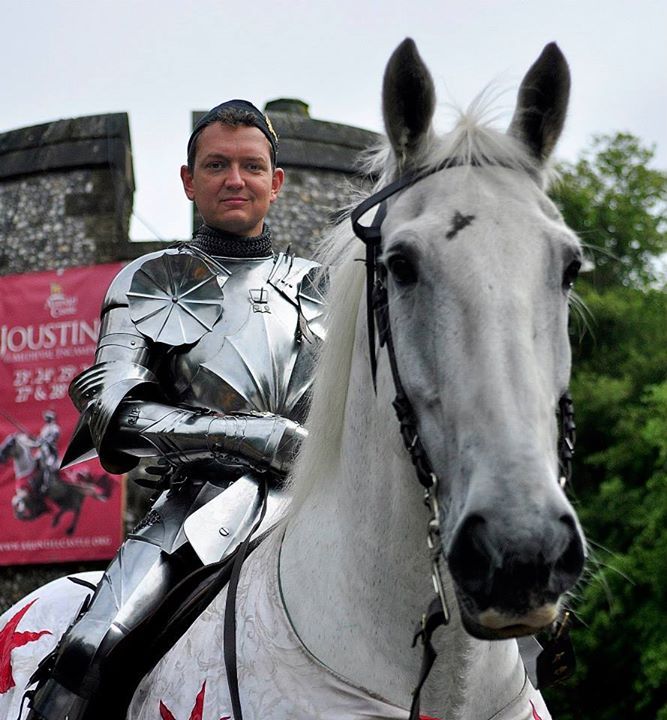
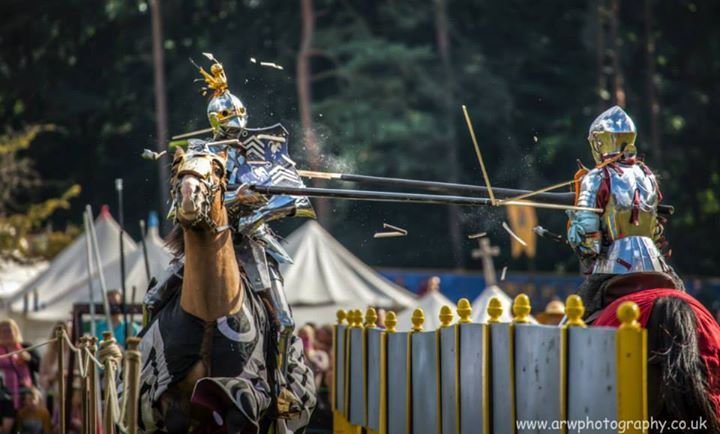

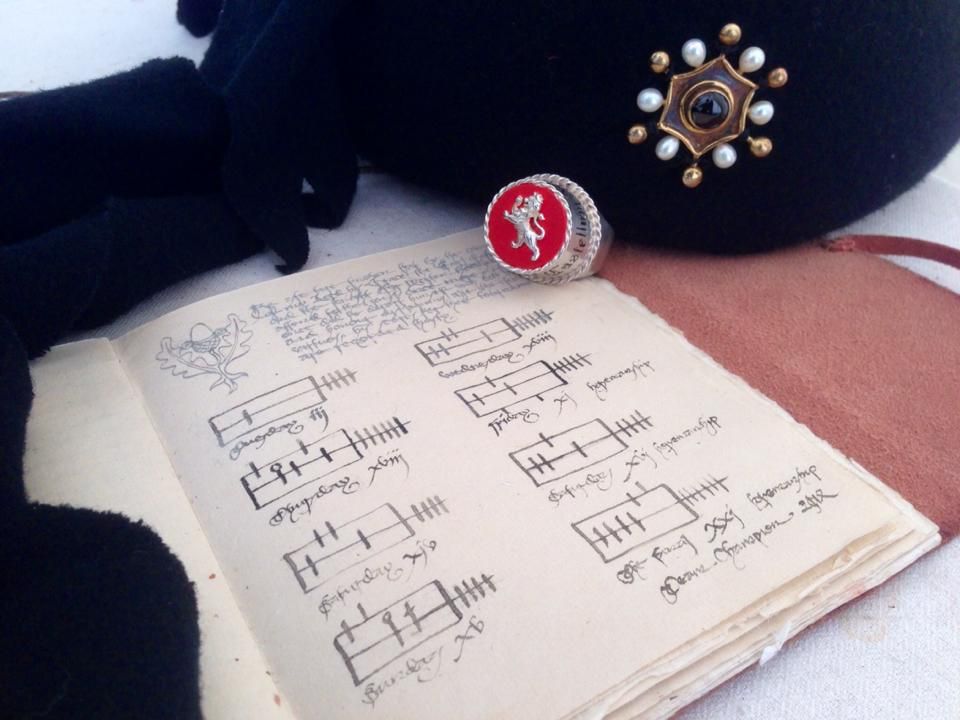
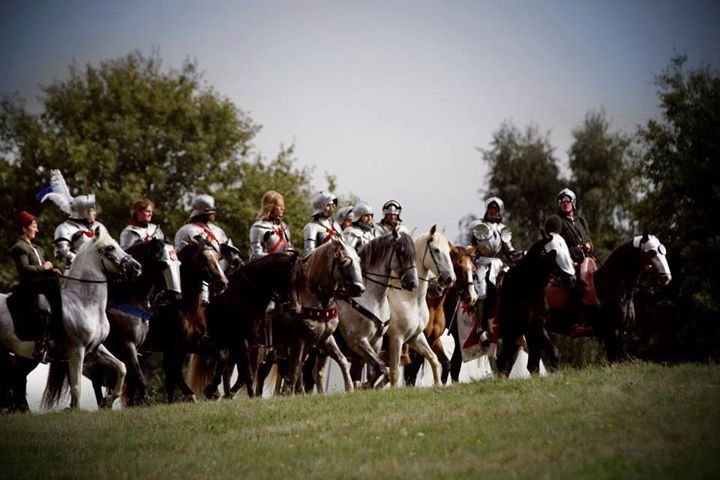

I bought this watch for my dad on this website on Father's Day. replica omega watchesThis watch has been bought since my father has been wearing it.fake omega de ville prestige watches It has been running and working very hard. The key is that it looks no different from genuine and the design is perfect. He likes it very much.
ReplyDelete